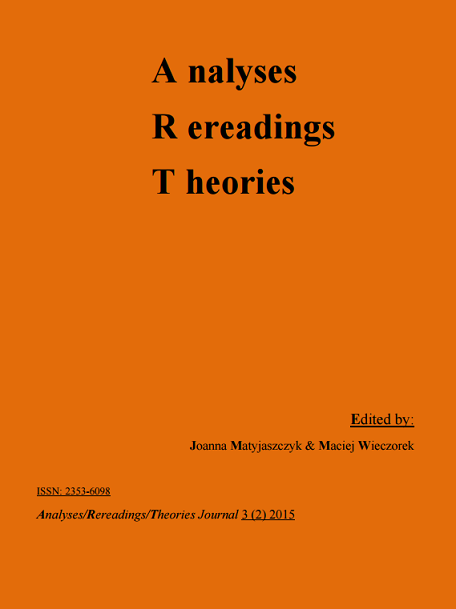Vision and Violence in Virginia Woolf’s The Waves
DOI:
https://doi.org/10.18778/2353-6098.3.09Keywords:
Virginia Woolf, The Waves, visual imagery, violenceAbstract
Virginia Woolf describes her artistic goal in The Waves as an attempt to create “an abstract mystical eyeless book.” Yet, in creating her eyeless book, one that eschews a single narrative perspective, Woolf amasses abundant visual details. For each of her six characters, visual images mark significant moments of being. In fact, Woolf emphasizes the characters’ capacity for sight as a vulnerability that allows them to be violated and wounded over and over. This article analyzes connections between visual imagery and themes of violence in the novel to demonstrate how they cohere into an extended metaphor for the ways in which acts of looking can elicit powerful emotions that threaten to fragment individual identity in painful ways. While Woolf’s novel has received critical commentary that focuses on the role of vision in the narrative and critics have also noted how violence in the text supports other themes, the explicit relationship between sight and violence has not yet been fully explored. A close examination of the visual imagery in key scenes of the novel demonstrates how Woolf engages the reader to participate in the characters’ deepening sense of fragmentation as they are repeatedly assaulted by experience, as the eyes themselves become symbols of the twin dynamics of desire and destruction.
References
Bradshaw, David, ed. Introduction to The Waves. Oxford: Oxford UP, 2015. Print.
Google Scholar
Clements, Elicia. “Transforming Musical Sounds into Words: Narrative Method in Virginia Woolf‘s The Waves.” Narrative 13.2 (2005): 160-81. JSTOR. Web. 10 Aug. 2015.
Google Scholar
DOI: https://doi.org/10.1353/nar.2005.0008
Cuddy-Keane, Melba. “Virginia Woolf, Sound Technologies, and the New Aurality.” Virginia Woolf in the Age of Mechanical Reproduction. Ed. Pamela L. Caughie. New York: Garland Publishing, Inc., 2000. 69-96. Print.
Google Scholar
Ender, Evelyn. Architexts of Memory: Literature, Science, and Autobiography. AnnArbor: U of Michigan P, 2005. Print.
Google Scholar
DOI: https://doi.org/10.3998/mpub.132189
Fand, Roxanne. The Dialogic Self: Reconstructing Subjectivity in Woolf, Lessing, and Atwood. Susquehanna: Susquehanna UP, 1999. Print.
Google Scholar
Griffin, Roger. Modernism and Fascism: The Sense of a Beginning Under Mussolini and Hitler. New York: Macmillan, 2007. Print.
Google Scholar
DOI: https://doi.org/10.1057/9780230596122
Johnson, Roy. Rev. of Virginia Woolf as a “Cubist Writer,” by Sarah Latham Phillips. Mantex. Web. 15 Aug. 2015. <http://www.mantex.co.uk/reviews/>.
Google Scholar
Kelley, Alice van Buren. The Novels of Virginia Woolf: Fact and Vision. Chicago: U of Chicago P, 1973. Print.
Google Scholar
Luttrell, Rosemary. “Virginia Woolf‘s Emersonian Metaphors of Sight in To the Lighthouse: Visionary Oscillation.” Journal of Modern Literature 36.3 (2013): 69-79. Project Muse. Web. 12 Aug. 2015.
Google Scholar
DOI: https://doi.org/10.2979/jmodelite.36.3.69
Monson, Tamlyn. “‘A trick of the mind’: Alterity, Ontology, and Representation in Virginia Woolf‘s The Waves.” Modern Fiction Studies 50.1 (2004): 173-96. ProjectMuse. Web. 12 Aug. 2015.
Google Scholar
DOI: https://doi.org/10.1353/mfs.2004.0012
Richter, Harvena. Virginia Woolf: The Inward Voyage. Princeton: Princeton UP, 1970. Print.
Google Scholar
Taylor, Chloe. “Kristevan Themes in Virginia Woolf‘s The Waves.” Journal of Modern Literature 29.3 (2006): 57-77. Project Muse. Web. 14 Aug. 2015.
Google Scholar
DOI: https://doi.org/10.1353/jml.2006.0036
Thakur, N. C. The Symbolism of Virginia Woolf. Oxford: Oxford UP, 1965. Print.
Google Scholar
Woolf, Virginia. The Diary of Virginia Woolf Volume 3: 1925-1930. [November 7,1928]. Ed. Ann Olivier Bell. York: Harcourt, 1980. Print.
Google Scholar
Woolf, Virginia. “Modern Fiction.” The Common Reader. Ed. David Bradshaw. New York: Harcourt, 1953. 146-54. Print.
Google Scholar
Woolf, Virginia. “A Sketch of the Past.” Moments of Being: A Collection of Autobiographical Writing. Ed. Jeanne Schulkind. New York: Harcourt, 1985. 61-160. Print.
Google Scholar
Woolf, Virginia. “The Sun and the Fish.” Selected Essays. Ed. David Hume. Oxford: Oxford UP, 2008. Oxford World‘s Classics. 188-92. Print.
Google Scholar
Woolf, Virginia. The Waves. New York: Harcourt, 1959. Print.
Google Scholar
Downloads
Published
How to Cite
Issue
Section
License

This work is licensed under a Creative Commons Attribution-NonCommercial-NoDerivatives 3.0 Unported License.









